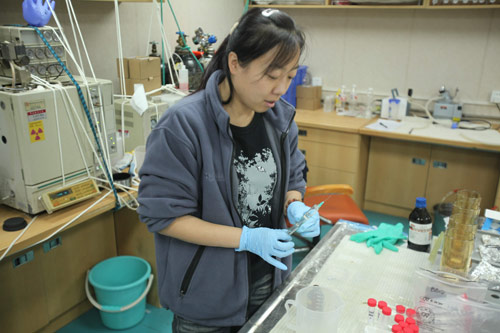Climate change comes before honeymoon for 'bride'
Updated: 2012-10-18 10:14
By Xie Chuanjiao in Qingdao (China Daily)
|
|||||||||||
 |
|
Li Chengxuan works in a lab to analyze the data she and her colleagues had collected during their three-month expedition to the North Pole. Provided to China Daily |
Although many people long to see the beauty of the aurora and polar bears, few have the chance or guts to go to the so-called end of the earth to get firsthand experience.
Li Chengxuan, a 30-year-old scientist, did so recently - three days after her wedding and without her husband.
The newlywed set off for a three-month expedition to the North Pole with China's icebreaker Xuelong from July 2-Sept 27.
"I was called 'the bride' during the whole Arctic trip," Li says in between giggles. "My husband and I ended up spending our honeymoon sending text messages to each other. But I've no regrets - the exploration of the North Pole is too valuable, and my husband understands me very well."
Li, a researcher at the No 1 Institute of Oceanography of the State Oceanic Administration in Qingdao, Shandong province, was among the 119-member team of China's fifth Arctic expedition.
The team was made up of more than 20 institutes. There were also scientists from Iceland, the US and France.
"No matter where we are from, we all work in one team and cooperate closely. When I'm done with my part of the job, I give a hand to my foreign friends and vice versa," Li says.
There was no rest after the trip. Immediately after the team came home, Li buried herself in a lab to analyze the data she and her colleagues had collected.
Li is responsible for testing the level of oceanic dimethylsulfide, a major natural source of sulfur in the atmosphere, which serves as a key indicator of climate change.
"It's the first time that China has conducted this kind of test in the Arctic area, and the result will contribute to subjects related to global warming and the melting of ice caps," Li says.
They set up more than 90 hydrometric stations along the way and conducted two to three hours of research at each stop. The scientists often have to work for more than 20 hours a day - collecting, sampling and analyzing the surrounding water.
"The bright side is that we had a dedicated crew who made sure there was warm food available around the clock in the canteen. They even delivered food to our post if we were too busy," Li says.
She also expressed her appreciation for their sentry, who watched for polar bears on the ice caps.
"The guy has to carry a heavy gun and stand on the extremely cold ice for about four hours straight to protect us," she says. "Fortunately, he did not have to fire a single bullet since no bears tried to attack."
Despite the care and sufficient food, Li lost 4 kg.
The most interesting part of the trip included seeing polar bears and participating in onboard entertainment activities, such as karaoke contests and calisthenics.
"We saw polar bears three times and videotaped the encounters. They are so cute. I feel sad the bears' habitat is under constant threat from the melting of ice caps," she says.
xiechuanjiao@chinadaily.com.cn
Related Stories
Works like a charm 2012-07-25 09:35
'One suicide is too many' 2012-07-24 09:07
Art ambassadors 2012-07-10 10:27
Monkey see, monkey do 2012-04-11 09:53
Designing Impact, Approaches to Practical Research 2011-11-04 14:16
Today's Top News
Rescuers race against time for quake victims
Telecom workers restore links
Coal mine blast kills 18 in Jilin
Intl scholarship puts China on the map
More bird flu patients discharged
Gold loses sheen, but still a safe bet
US 'turns blind eye to human rights'
Telecom workers restore links
Hot Topics
Lunar probe , China growth forecasts, Emission rules get tougher, China seen through 'colored lens', International board,
Editor's Picks

|

|

|

|

|

|





